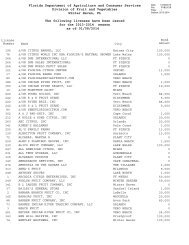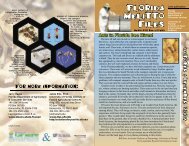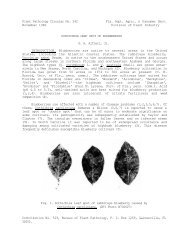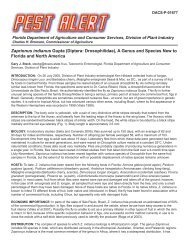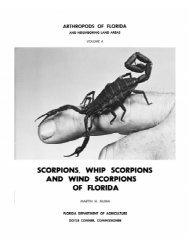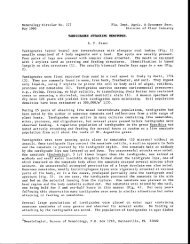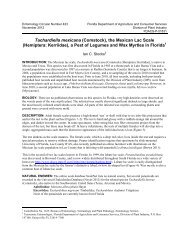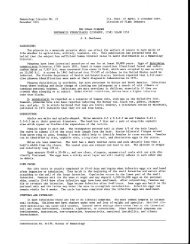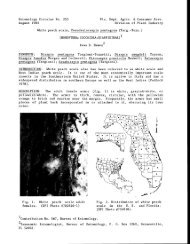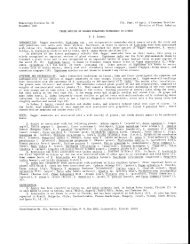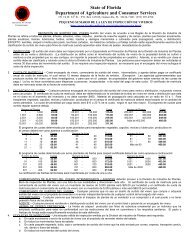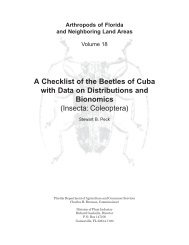Florida Cooperative Agricultural Pest Survey Program
Florida Cooperative Agricultural Pest Survey Program
Florida Cooperative Agricultural Pest Survey Program
You also want an ePaper? Increase the reach of your titles
YUMPU automatically turns print PDFs into web optimized ePapers that Google loves.
<strong>Florida</strong> <strong>Cooperative</strong> <strong>Agricultural</strong> <strong>Pest</strong> <strong>Survey</strong> <strong>Program</strong><br />
Quarterly Report No. 4-2008<br />
October 1 to December 31, 2008<br />
<strong>Florida</strong> Department of Agriculture and Consumer Services<br />
Division of Plant Industry<br />
1911 SW 34 th Street<br />
PO Box 147100<br />
Gainesville, FL 32608<br />
352.372.3505<br />
Table of Contents:<br />
Table of Contents:................................................................................................................................ 2<br />
Introduction.......................................................................................................................................... 3<br />
NAPIS Data Base................................................................................................................................. 3<br />
Networking: ......................................................................................................................................... 7<br />
Data Management:............................................................................................................................... 8<br />
<strong>Pest</strong> List:............................................................................................................................................. 12<br />
<strong>Pest</strong> Risk and Pathway Analysis:....................................................................................................... 12<br />
<strong>Survey</strong>s Conducted and Results:........................................................................................................ 12<br />
Red Palm Mite (RPM) <strong>Survey</strong>: ..................................................................................................................................... 12<br />
Solid Wood Packing Materials (SWPM), Sirex noctilio USDA Initiative, and Red Bay Ambrosia Beetle ................... 12<br />
Texas Phoenix Palm Decline (TPPD) <strong>Survey</strong>:.............................................................................................................. 13<br />
Light Brown Apple Moth (LBAM) <strong>Survey</strong>: ................................................................................................................... 13<br />
Spodoptera <strong>Survey</strong>:....................................................................................................................................................... 13<br />
Performance Measures....................................................................................................................... 13<br />
Public Outreach and Risk Communication:....................................................................................... 15<br />
Webpage (<strong>Florida</strong>-CAPS):................................................................................................................. 16<br />
FDACS/DPI CAPS Personnel: .......................................................................................................... 17<br />
Photograph Credits: ........................................................................................................................... 17<br />
Maps:.................................................................................................................................................. 18<br />
Map 1: Chrysanthemum white rust survey map developed for surveyors..................................................................... 18<br />
Map 2: Texas Phoenix palm decline survey map developed for surveyors................................................................... 19<br />
Map 3: Counties and locations where Texas phoenix palm decline has been found. ................................................... 20<br />
Figures: .............................................................................................................................................. 23<br />
Figure 1: CAPS downloadable calendar, November................................................................................................... 23<br />
Photos:................................................................................................................................................ 24<br />
Photo 2: Bucket trap baited with Helicoverpa armigera pheromone lure in a soybean field....................................... 25<br />
Photo 3: Dr. Ashley Johnson checking a Jackson trap for light brown apple moth..................................................... 25<br />
2
Introduction<br />
The <strong>Florida</strong> Department of Agriculture and Consumer Services (FDACS), Division of Plant Industry<br />
(DPI), <strong>Cooperative</strong> Agriculture <strong>Pest</strong> <strong>Survey</strong> (CAPS) program was engaged in many program activities<br />
including data entry, survey, public outreach, training and program development. Information on each<br />
program area is detailed in this report.<br />
NAPIS Data Base<br />
Cyndi Moncrief (FDACS-CAPS Public Information Specialist) has continued to enter the daily citrus<br />
greening pathology results data, monthly fruit fly trapping data, and US, State, County, and Host<br />
records as they became available.<br />
Table 1a. <strong>Pest</strong> records entered into the NAPIS database, 4th Quarter 2008.<br />
U.S. Records<br />
<strong>Pest</strong> Scientific Name <strong>Pest</strong> Common Name Host Scientific Name Host Common Name County<br />
Leptocybe invasa Fisher & LaSalle blue gum chalcid wasp Eucalyptus sp. Eucalyptus Broward<br />
Total =1<br />
State Records<br />
<strong>Pest</strong> Scientific Name <strong>Pest</strong> Common Name Host Scientific Name Host Common Name County<br />
Colletotrichum dracaenophilum an anthracnose<br />
Total =1<br />
Dracaena sanderiana hort.<br />
ex Rev.<br />
3<br />
lucky bamboo,<br />
Belgian evergreen Miami-Dade<br />
County Records<br />
<strong>Pest</strong> Scientific Name <strong>Pest</strong> Common Name Host Scientific Name Host Common Name County<br />
Andrallus spinidens (Fabricius) predaceous stinkbug N/A N/A Hillsborough<br />
Melaleuca quinquenervia paperbark, punk tree,<br />
Boreioglycaspis melaleucae Moore melaleuca psyllid (Cav.) S.T. Blake<br />
or melaleuca Hillsborough<br />
Curtara insularis Caldwell ringspot leafhopper Psidium guajava L. guava<br />
St. Lucie<br />
Diaditus pictipes Champion an assassin bug N/A N/A Jefferson<br />
Ischnodemus sallei (=fulvipes)<br />
fireflag, bent<br />
(Signoret) a seed bug Thalia geniculata L.<br />
Eriobotrya japonica<br />
alligatorflag Alachua<br />
Leptoglossus concolor (Walker) a leaffooted bug<br />
(Thunb.) Lindl.<br />
Eriobotrya japonica<br />
loquat Palm Beach<br />
Leptoglossus zonatus (Dallas) Western leaf-footed bug (Thunb.) Lindl. loquat Hillsborough<br />
Oncopeltus cayensis Torre-Bueno a seed bug Cyperus sp<br />
Argusia gnaphalodes (L.)<br />
umbrella sedge Hendry<br />
Orius tristicolor (White) minute pirate bug Heine sea rosemary<br />
coral tree, sunshine<br />
Monroe<br />
Quadrastichus erythrinae Kim Erythrina gall wasp Erythrina variegata L. tree Brevard<br />
Scirtothrips dorsalis Hood chili thrips Zinnia sp. zinnia Clay<br />
Singhiella simplex (Singh) fig whitefly Ficus benjamina L. weeping fig Lee<br />
Spodoptera pulchella (Herrich-<br />
Schaeffer) Caribbean armyworm Citrus sinensis (L.) Osbeck sweet orange Lee<br />
Xyleborus glabratus Eichhoff redbay ambrosia beetle Litsea aestivalis (L.) Fern. pondspice, pondbush St. Johns<br />
Total = 14
Host Records<br />
<strong>Pest</strong> Scientific Name <strong>Pest</strong> Common Name<br />
yellow scallop moth or<br />
Host Scientific Name Host Common Name County<br />
Anomis erosa Hubner<br />
mallow caterpillar Talipariti tiliaceum sea hibiscus; mahoe Miami-Dade<br />
Antonina graminis nr. (Maskell) Rhodesgrass Mealybug Zea mays L.<br />
Ravenia spectablilis<br />
corn Miami-Dade<br />
Diaphorina citri Kuwayama Asian citrus psyllid (Lindl.) Planch. Ex. Griseb. a citrus Miami-Dade<br />
Duplachionaspis divergens Green armored scale Zea mays L.<br />
Dichorisandra thyrsiflora<br />
corn Miami-Dade<br />
Maconellicoccus hirsutus Green pink hibiscus mealybug Mikan. F. Hawaiian blue ginger<br />
Yesterday-today-and-<br />
Pinellas<br />
Maconellicoccus hirsutus Green pink hibiscus mealybug Brunfelsia grandiflora tomorrow St Lucie<br />
Maconellicoccus hirsutus Green pink hibiscus mealybug Chrysophyllum sp. chrysophyllum Orange<br />
Myllocerus undecimpustulatus<br />
yellow neckace pod,<br />
undatus Marshall<br />
Myllocerus undecimpustulatus<br />
a broadnosed weevil Sophora tomentosa L. silverbush Collier<br />
undatus Marshall<br />
Myllocerus undecimpustulatus<br />
a broadnosed weevil Solanum diphyllum L. nightshade Pinellas<br />
undatus Marshall a broadnosed weevil Turnera ulmifolia L. yellow alder Pinellas<br />
Myllocerus undecimpustulatus<br />
Dalbergia ecastophyllum<br />
undatus Marshall a broadnosed weevil (L.) Taubert<br />
Senna pendula (Humb. &<br />
coinvine Pinellas<br />
Myllocerus undecimpustulatus<br />
Bonpl. Ex. Willd.) Irwin &<br />
undatus Marshall<br />
Myllocerus undecimpustulatus<br />
a broadnosed weevil Barneby Christmas cassia Manatee<br />
undatus Marshall a broadnosed weevil Sida cordifolia L. lima Miami-Dade<br />
Myllocerus undecimpustulatus<br />
Antigonon leptopus Hook. Coral Vine; Queens<br />
undatus Marshall a broadnosed weevil & Arn.<br />
Wreath Miami-Dade<br />
Myllocerus undecimpustulatus<br />
Chamaesyce hypericifolia graceful sandmat;<br />
undatus Marshall a broadnosed weevil (L.) Millsp.<br />
spurge Pinellas<br />
Myllocerus undecimpustulatus<br />
Laguncularia racemosa<br />
undatus Marshall a broadnosed weevil (L.) Gaertn. F. white mangrove Pinellas<br />
Myllocerus undecimpustulatus<br />
Caesalpinia bonduc (L.)<br />
undatus Marshall a broadnosed weevil Roxb. grey knickerbean Pinellas<br />
Myllocerus undecimpustulatus<br />
Ixora, flame-of-the-<br />
undatus Marshall a broadnosed weevil Ixora coccinea L.<br />
jungle Pinellas<br />
Myllocerus undecimpustulatus<br />
Rondeletia leucophylla<br />
undatus Marshall a broadnosed weevil H.B. & K. Panama rose Pinellas<br />
Myllocerus undecimpustulatus<br />
Cnidoscolus chayamansa<br />
undatus Marshall<br />
Myllocerus undecimpustulatus<br />
a broadnosed weevil Mcvaugh spinach tree, chaya Miami-Dade<br />
undatus Marshall a broadnosed weevil Bougainvillea spp<br />
Dactyloctenium aegyptium<br />
bougainvillea Pinellas<br />
Myllocerus undecimpustulatus<br />
(L.) Willd. Ex. Asch. &<br />
undatus Marshall<br />
Paratachardina pseudolobata Kondo<br />
a broadnosed weevil Schwenif. crowfoot grass Pinellas<br />
& Gullan lobate lac scale Euodia elleryana F.Muell. corkwood Miami-Dade<br />
Planchonia stentae Brain euphorbia pit scale Cajanus cajan (L.) Millsp. pigeonpea<br />
grassy-leaved<br />
Miami-Dade<br />
Pseudaulacaspis cockerelli (Cooley) magnolia white scale Acorus gramineus Ait.<br />
Antidesma bunius (L.)<br />
sweetflag Alachua<br />
Retithrips syriacus (Mayet) castor thrips<br />
Spreng. bignay chinalaurel Miami-Dade<br />
Rhopalosiphum rufiabdominale<br />
Ravenea rivularis Jumelle<br />
(Sasaki) rice root aphid<br />
& Perrier majesty palm Palm Beach<br />
Scirtothrips dorsalis Hood chili thrips Salix sp. willow Lake<br />
Scirtothrips dorsalis Hood chili thrips Nandina domestica Thunb. heavenly bamboo Lake<br />
Scirtothrips dorsalis Hood chili thrips Eugenia uniflora L.<br />
Sapium sebiferum (L.)<br />
surinam cherry Miami-Dade<br />
Scirtothrips dorsalis Hood chili thrips<br />
Roxb. chinese tallow Alachua<br />
Ludwigia peruviana (L.) Peruvian primrose-<br />
Scirtothrips dorsalis Hood chili thrips<br />
Hara<br />
willow Miami-Dade<br />
Viburnum odoratissimum sweet arrowwood /<br />
Thrips palmi Karny<br />
Total = 33<br />
melon thrips<br />
Ker-Gawl.<br />
sweet viburnum Lake<br />
4
Table 1b. Historical pest records entered into NAPIS database.<br />
HISTORICAL U.S. Plant <strong>Pest</strong><br />
Records<br />
<strong>Pest</strong> Scientific Name <strong>Pest</strong> Common Name Host Scientific Name Host Common Name County Year<br />
N/A<br />
Total = 0<br />
HISTORICAL State Plant <strong>Pest</strong><br />
Records<br />
<strong>Pest</strong> Scientific Name <strong>Pest</strong> Common Name Host Scientific Name Host Common Name<br />
beach sunflower,<br />
County Year<br />
Orius tristicolor (White) minute pirate bug Helianthus debilis Nutt. dune sunflower Brevard 1998<br />
Total = 1<br />
HISTORICAL County Plant<br />
<strong>Pest</strong> Records<br />
<strong>Pest</strong> Scientific Name <strong>Pest</strong> Common Name Host Scientific Name Host Common Name County Year<br />
Orius tristicolor (White) minute pirate bug Sida acuta Burm. F. common wireweed Miami-Dade 2007<br />
Total = 1<br />
HISTORICAL Host Plant <strong>Pest</strong><br />
Records<br />
<strong>Pest</strong> Scientific Name <strong>Pest</strong> Common Name Host Scientific Name Host Common Name County Year<br />
N/A<br />
Total = 0<br />
Table 2a. Counties with new records for all categories sorted most to least, 4th Quarter 2008.<br />
County # of Records County # of Records<br />
Miami-Dade 13 Broward 1<br />
Pinellas 11 Clay 1<br />
Alachua 3 Collier 1<br />
Hillsborough 3 Hendry 1<br />
Lake 3 Jefferson 1<br />
Lee 2 Manatee 1<br />
Palm Beach 2 Monroe 1<br />
St Lucie 2 Orange 1<br />
Brevard 1 St Johns 1<br />
Table 2b. Counties with new historical records<br />
for all categories sorted most to least.<br />
County # of Records<br />
Brevard 1<br />
Miami-Dade 1<br />
Total = 2<br />
5<br />
Total = 49
Table 3a. U.S./State records for plant pests only, 4th Quarter 2008.<br />
U.S. Plant <strong>Pest</strong> Records<br />
<strong>Pest</strong> Scientific Name <strong>Pest</strong> Common Name Host Scientific Name Host Common Name County<br />
Leptocybe invasa Fisher &<br />
LaSalle blue gum chalcid wasp Eucalyptus sp. eucalyptus Broward<br />
Total = 1<br />
State Plant <strong>Pest</strong> Records<br />
<strong>Pest</strong> Scientific Name <strong>Pest</strong> Common Name Host Scientific Name Host Common Name County<br />
Colletotrichum dracaenophilum an anthracnose<br />
Total = 1<br />
Dracaena sanderiana hort.<br />
ex Rev.<br />
Table 3b. Historical U.S./State records for plant pests only.<br />
HISTORICAL U.S. Plant <strong>Pest</strong><br />
Records<br />
<strong>Pest</strong> Scientific Name<br />
N/A<br />
Total = 0<br />
HISTORICAL State Plant <strong>Pest</strong><br />
Records<br />
<strong>Pest</strong> Scientific Name<br />
<strong>Pest</strong> Common<br />
Name<br />
<strong>Pest</strong> Common<br />
Name<br />
Orius tristicolor (White) minute pirate bug<br />
Total = 1<br />
Host Scientific<br />
Name<br />
Host Scientific<br />
Name<br />
Helianthus debilis<br />
Nutt.<br />
6<br />
lucky bamboo, Belgian<br />
evergreen Miami-Dade<br />
Host Common<br />
Name County Year<br />
Host Common<br />
Name<br />
beach sunflower,<br />
County Year<br />
dune sunflower Brevard 2001<br />
Table 4. State survey records entered into CAPS/NAPIS data base, 4th Quarter 2008.<br />
State <strong>Pest</strong> <strong>Survey</strong> Efforts<br />
Target Organism Scientific Name Target Organism Common Name<br />
Counties<br />
<strong>Survey</strong>ed # of Records<br />
Anastrepha ludens Mexican fruit fly 40 132<br />
Bactrocera cucurbitae melon fruit fly 41 117<br />
Bactrocera dorsalis Oriental/guava fruit fly 41 117<br />
Ceratitis capitata Mediterranean fruit fly 41 117<br />
Cernuella virgata and Alectra vogelii Soybean Commodity <strong>Survey</strong> (SBCS) 9 38 *1<br />
Commodity <strong>Survey</strong>s - Citrus Citrus commodity survey (CCS) 2 510 *2<br />
Commodity <strong>Survey</strong>s - Oak see LBAM, AGM, and PGM above N/A N/A<br />
Commodity <strong>Survey</strong>s - Potato Potato Cyst Nematode <strong>Survey</strong> (PCN) 2 6 *3<br />
Epiphyas postvittana Light Brown Apple Moth <strong>Survey</strong> (LBAM) 29 682 *4<br />
Helicoverpa armigera<br />
cotton bollworm (HA), part of oak<br />
commodity survey 9 116 *5<br />
Liberobacter asiasticus citrus greening disease (Asian strain) 33 1819<br />
Lymantria dispar Asian gypsy moth (AGM) 20 119 *6<br />
Lymantria mathura Pink gypsy moth (PGM) 20 118 *6<br />
Monochamus,Trypodendron, Xylosandrus Bark Beetle <strong>Survey</strong> (SWPM other entries) 17 366 *7<br />
Phytophthora ramorum sudden oak death (SOD) N/A N/A<br />
Puccinia horiana chrysanthemum white rust (CWR) N/A N/A<br />
Puccinia kuehnii orange rust of sugarcane N/A N/A<br />
Raoiella indica Red Palm Mite <strong>Survey</strong> (RPM) 14 2096 *8<br />
Sirex noctilio Bark Beetle <strong>Survey</strong> (SWPM / Sirex) 17 139 *9<br />
Spodoptera littoralis Egyptian cottonworm N/A N/A
Spodoptera litura rice cutworm (RCW) 6 181 *10<br />
Steneotarsonemus spinki panicle rice mite survey (PRM) 1 *11 N/A<br />
Uromyces transversalis gladiolus rust (GR) N/A N/A<br />
Xylella fastidiosa citrus variegated chlorosis (CVC) N/A N/A<br />
7<br />
Total = 6673<br />
*1 SBCS: 38 records represent 19 records each of Cernuella virgata (a snail) and Alectra vogelii (a weed), as part of the<br />
Soybean Commodity <strong>Survey</strong>. No suspects were found and no samples were taken; 9 counties surveyed: Calhoun, Escambia,<br />
Gadsden, Holmes, Jackson, Jefferson, Madison, Okaloosa, Santa Rosa.<br />
*2 CCS: 510 records represent 170 each of Ceroplastes destructor, Planococcus minor, and Eutranychus orientalis. 170<br />
plants were surveyed, and 32 specimens were submitted for ID (all negative) from two counties: Broward and Miami-Dade.<br />
*3<br />
(PCN Qtr 4) 6 records represent 10 negative samples each for G. pallida and G. rostochiensis, in 2 counties (Putnam<br />
and St Johns)<br />
*4 LBAM: 682 records represent 235 negative samples (86 samples submitted for analysis) from 29 counties (Alachua,<br />
Baker, Bradford, Brevard, Broward, Charlotte, Collier, Columbia, De Soto, Duval, Escambia, Hardee, Hernando,<br />
Highlands, Hillsborough, Indian River, Jackson, Lee, Leon, Manatee, Marion, Miami-Dade, Orange, Palm Beach,<br />
Pinellas, Polk, Sarasota, St. Lucie, Volusia).<br />
*5 HA (part of Soybean Commodity <strong>Survey</strong>): 116 records represent 989 moths from 21 traps in 9 counties: Calhoun,<br />
Escambia, Gadsden, Holmes, Jackson, Jefferson, Madison, Okaloosa, Santa Rosa<br />
*6 AGM and PGM: represents 2007 and 2008 totals. 108 records (AGM+PGM) were from 2008, and 129 records<br />
(AGM+PGM) were from 2007. In 2008, 217 traps from 18 counties were checked and 3 positive AGM were found. In 2007,<br />
240 traps from 20 counties checked and 1 positive AGM was found. The counties checked in 2008 were: Alachua, Bay,<br />
Bradford, Columbia, Gadsden, Gilchrist, Hamilton, Jackson, Jefferson, Leon, Liberty, Madison, Nassau, Okaloosa, Santa<br />
Rosa, Suwanee, Union and Wakulla.<br />
*7 SWPM/other: 366 records represent 122 entries each of Monochamus alternatus, Trypodendron domesticus, and<br />
Xylosandrus mutilatus. 6195 negative samples were collected and screened from 17 counties (Bay, Brevard, Broward,<br />
Duval, Escambia, Franklin, Highland, Hillsborough, Lee, Leon, Wakulla, Manatee, Miami-Dade, Orange, Santa Rosa,<br />
Sarasota, and St Lucie).<br />
*8 RPM: 2096 records represent 4701 plants surveyed during July, August, and September 2008 (224 samples taken plus<br />
1872 negatives surveyed) in 14 counties (Broward, Charlotte, Collier, DeSoto, Glades, Hillsborough, Lee, Manatee,<br />
Martin, Miami-Dade, Monroe, Palm Beach, Pinellas, and Sarasota).<br />
*9 SWPM/Sirex: 139 records (114 were Sirex and 25 were RBAB) represent 6433 negative SWPM/Sirex/RBAB samples<br />
collected during June through October 2008 from 17 counties (Bay, Brevard, Broward, Duval, Escambia, Franklin,<br />
Highland, Hillsborough, Lee, Leon, Wakulla, Manatee, Miami-Dade, Orange, Santa Rosa, Sarasota, and St Lucie).<br />
*10 RCW: 181 records represent 816 negative moth samples from 22 traps, in 6 counties (DeSoto, Lake, Miami-Dade,<br />
Orange, Osceola, Polk). Note: most but not all of the December 2008 trapping results were included in these numbers.<br />
*11 PRM: <strong>Survey</strong> was completed in August 2008, but final lab results not available as of December 31, 2008.<br />
Networking: Contact with State entities and other stakeholders (include training, co-op agreement<br />
activities, and rapid response planning):<br />
The entire CAPS team maintained their regular contacts with CBP and USDA personnel at the ports,<br />
FDACS-DPI inspectors when dealing with nurseries, and other agencies within the federal, state and<br />
university systems for various projects.
Dr. Trevor Smith (FDACS-CAPS State <strong>Survey</strong> Coordinator) participated in several Eastern Region<br />
and Southern Plant Board, State <strong>Survey</strong> Coordinator Conference calls.<br />
Dr. Trevor Smith participated in a national PCN conference call.<br />
Dr. Trevor Smith and Doug Restom Gaskill (USDA-CAPS <strong>Pest</strong> <strong>Survey</strong> Specialist) coordinated survey<br />
activities for Texas phoenix palm decline between IFAS, DPI and the USDA.<br />
Dr. Ashley Johnson (FDACS-CAPS <strong>Pest</strong> <strong>Survey</strong> Specialist) continued to work with DPI plant<br />
inspectors Michael Bentley, Larry Smith and Robbie Robinson to continue implementation of SWPM,<br />
LBAM and Helicoverpa armigera trapping initiatives in the Panhandle region.<br />
Dr. Ashley Johnson continued to work with UF-IFAS Extension personnel to conclude Helicoverpa<br />
armigera trapping and conduct surveys for yellow witchweed (Alectra vogelii) and vineyard snail<br />
(Cernuella virgata) as part of the CAPS Soybean Commodity survey.<br />
David Saeger (FDACS-CAPS GIS/Mapping Specialist) took part in New Urban Research’s Workshop<br />
on mapping Census Bureau information.<br />
David Saeger also attended the Seven Hill Regional User Group (SHRUG) conference in Tallahassee<br />
which afforded him the opportunity to network and develop valuable contacts in the GIS/mapping<br />
community.<br />
Data Management: (includes oversight/coordination of state entry activities, timely and<br />
accurate entries with list of pest entered)<br />
Citrus Commodity survey – Cyndi Moncrief developed and maintained a new Citrus Commodity<br />
<strong>Survey</strong> database in Excel this quarter. Field Report Forms from the South <strong>Florida</strong> PSS were emailed to<br />
Cyndi on a monthly basis, and these numbers were transferred into the Excel database, organized and<br />
then resaved and exported in a format compatible for upload into NAPIS. Cyndi coordinated<br />
specimens received by courier each week and final specimen reports of positives and negatives from<br />
DPI. Cyndi also performed other analyses on the survey data as needed. This survey ended on<br />
December 31, 2008.<br />
Citrus Greening / HLB - Cyndi Moncrief continuously maintained and updated the Citrus Greening<br />
database in Excel. She downloaded all the citrus greening pathology results posted by FDACS/DPI<br />
Advanced Diagnostic Laboratory on the CHRP intranet home page. These numbers were transferred<br />
into the Excel database, organized and then resaved and exported in a format compatible for upload<br />
into NAPIS. Cyndi also performed other analyses on the survey data as needed. This survey is ongoing.<br />
Asian Citrus Psyllid – David Saeger continuously updated the ACP map showcasing the counties that<br />
are quarantined for Citrus greening. He also created different versions of this map one of which was<br />
created specifically for a presentation given by Dr. Wayne Dixon (FDACS-DPI Assistant Director)<br />
focusing on the counties of Alabama. These maps are stored at:<br />
\\ftlpla004\DPI_GIS_Data\ENPP\CAPS\David\Maps\AsianCitrusPsyllid<br />
Light Brown Apple Moth (LBAM) survey (part of Oak Commodity <strong>Survey</strong>) – Cyndi Moncrief<br />
maintained and continuously updated the LBAM database in Excel. Field report forms from surveyors<br />
were emailed to Cyndi on a weekly basis, and these numbers were transferred into the Excel database,<br />
organized and then resaved and exported in a format compatible for upload into NAPIS. Cyndi<br />
8
coordinated the processing and data capture of specimens received by courier each week as well as<br />
final Specimen Reports of positives and negatives from DPI and from the USDA Identifier. Cyndi also<br />
performed other analyses on the survey data as needed as well as keeping an updated list of the<br />
location of current traps in the field, their GPS coordinates and physical address and the assigned<br />
surveyor(s).<br />
A new task performed for the fourth quarter, which ended as of November 30, 2008, was reformatting<br />
the Light Brown Apple Moth (LBAM) survey data for transfer into the USDA-ISIS database for the<br />
National LBAM <strong>Survey</strong>. Cyndi would VPN directly into the online USDA-ISIS database and upload<br />
each month’s data. The months of October and November were completed according to the National<br />
Protocol and schedule, and the ISIS portion of this project is now finished.<br />
The final part of the LBAM/Oak Commodity <strong>Survey</strong> was entering the results of DPI’s annual Gypsy<br />
Moth survey into NAPIS. Chris Zamora (FDACS-DPI) provided data from DPI-Plant Inspection for<br />
the 2006-2008 gypsy moth surveys, and Cyndi accomplished the formatting and uploading of the 2007<br />
and 2008 gypsy moth data into NAPIS. The 2006 data will be completed at a later date, as well as<br />
some additional survey data from the US Dept. of Forestry survey results forwarded by Dr. Wayne<br />
Dixon.<br />
Cyndi also set up and maintains an online Google map of the CAPS LBAM <strong>Survey</strong> traps in <strong>Florida</strong>,<br />
which can be seen at:<br />
http://maps.google.com/maps/ms?hl=en&ie=UTF8&msa=0&msid=107014675511423579226.00045059cbc<br />
79d3d5adba&ll=28.526622,-83.693848&spn=5.866934,8.547363&z=7<br />
Red Palm Mite (RPM) survey – Cyndi Moncrief received monthly data from Doug Restom Gaskill,<br />
who maintained the RPM database in Microsoft Access. This data was then transferred into an Excel<br />
database, reorganized and checked for completeness, and then resaved and exported in a format<br />
compatible for upload into NAPIS. Cyndi coordinated the processing and data capture of arriving<br />
specimens and she archived final specimen reports of positives and negatives from DPI. Cyndi also<br />
performed other analyses on the survey data as needed.<br />
David performed weekly updates of the RPM map hosted on the CAPS website, at:<br />
http://www.doacs.state.fl.us/pi/caps/rpm_maps/RPM_Base_Map_34x44.pdf<br />
After receiving the raw data from Doug Restom Gaskill on Mondays, David formatted it for<br />
geocoding, making sure that the most recent confirmed RPM positive locations and sentinel sites are<br />
available for the public and private entities to access. He recently converted the map so that it<br />
highlights the sections in which RPM has been found as opposed to the individual finds. After it has<br />
been made available to DPI’s Publications Productions Specialist, Scott Weinberg, David stores the<br />
map here:<br />
\\ftlpla004\DPI_GISDATA\ENPP\CAPS\David\Maps\RedPalmMite\WebMap<br />
The current map has 309 positive sites and 2 interception sites.<br />
Rice cutworm, Spodoptera litura (RCW) survey – Cyndi Moncrief continuously maintained and<br />
updated the Spodoptera database in Excel. Field Report Forms from surveyors are emailed to Cyndi<br />
on a weekly basis, and these numbers were transferred into the Excel database, organized, and then<br />
resaved and exported in a format compatible for upload into NAPIS. Cyndi coordinated the processing<br />
and data capture of specimens received by courier each week and final specimen reports of positives<br />
and negatives from DPI and from the USDA Identifier. Cyndi also performed other analyses on the<br />
9
survey data as needed as well as keeping an updated list of the location of current traps in the field,<br />
their GPS coordinates and physical address, and the assigned surveyor(s).<br />
Cyndi set up and maintained an online Google map of the CAPS RCW <strong>Survey</strong> traps in <strong>Florida</strong>, which<br />
can be seen at:<br />
http://maps.google.com/maps/ms?hl=en&ie=UTF8&msa=0&msid=107014675511423579226.000450738e2<br />
96f93e372b&ll=27.117813,-81.210937&spn=5.943429,8.547363&z=7<br />
Solid Wood Packing Materials (SWPM)/Sirex noctilio survey – Cyndi Moncrief continuously<br />
maintained and updated the SWPM database in Excel. Cyndi organized specimens received by courier<br />
each week, and entered the results from the final ID and/or Specimen Report from DPI into the SWPM<br />
database. She then organized and resaved this data in a more compatible format for upload into<br />
NAPIS. For NAPIS, these results are reported as negatives for the following: Sirex noctilio,<br />
Monochamus alternatus, Trypodendron domesticus, Xylosandrus mutilatus, and, for a few<br />
appropriately-baited traps, also Xyleborus glabratus. Cyndi also performed other analyses on the<br />
survey data as needed as well as keeping an updated list of the location of current traps in the field,<br />
their GPS coordinates and physical address, and the assigned surveyor(s).<br />
Cyndi set up and maintains an online Google map of the CAPS SWPM <strong>Survey</strong> traps in <strong>Florida</strong>, which<br />
can be seen at:<br />
http://maps.google.com/maps/ms?hl=en&ie=UTF8&msa=0&msid=107014675511423579226.00045071266<br />
4044d3f65e&ll=28.275358,-83.594971&spn=5.880839,8.547363&z=7<br />
Soybean Commodity <strong>Survey</strong> (Helicoverpa armigera, Cernuella virgata and Alectra vogelii) – Cyndi<br />
Moncrief maintained a new Soybean Commodity <strong>Survey</strong> (SBCS) database in Excel this quarter. Field<br />
report forms from the North <strong>Florida</strong> PSS were emailed to Cyndi on a bi-weekly basis, and these<br />
numbers were transferred into the Excel database, organized, and then resaved and exported in a<br />
format compatible for upload into NAPIS. Cyndi coordinated the processing and data capture of<br />
specimens received by courier each week and final specimen reports of positives and negatives from<br />
DPI and from the USDA Identifier. Cyndi also performed other analyses on the survey data as needed<br />
as well as keeping an updated list of the location of current traps in the field, their GPS coordinates and<br />
physical address, and the assigned surveyor(s). This survey ended on October 31, 2008.<br />
Cyndi also set up and maintained an online Google map of the CAPS Helicoverpa <strong>Survey</strong> traps in<br />
<strong>Florida</strong>, which can be seen at:<br />
http://maps.google.com/maps/ms?f=q&hl=en&geocode=&ie=UTF8&msa=0&msid=1070146755114235792<br />
26.000456b860291b6cb41e8&ll=30.760719,-85.330811&spn=5.304432,7.998047&z=7<br />
David Saeger created a map showcasing all the Helicoverpa traps that Ashley set up and serviced.<br />
This map is stored at:<br />
\\ftlpla004\DPI_GIS_Data\ENPP\CAPS\David\Maps\Helicoverpa<br />
Cotton Seed Bug <strong>Survey</strong> – David Saeger created a map of the sentinel sites set up for Oxycarenus<br />
hyalinipennis this map is stored at:<br />
\\ftlpla004\DPI_GIS_Data\ENPP\CAPS\David\Maps\Oxycarenushyalinipennis<br />
Chrysanthemum White Rust – David Saeger created a series of maps to assist Doug Restom Gaskill<br />
and DPI in their survey for chrysanthemum white rust around the Yoder Bros. properties. He created a<br />
series of small scale maps around the two Yoder properties in Parish and Ft. Myers and included road<br />
layers, aerial photography, and an inset map that could be used to navigate around the perimeter of the<br />
nursery (Map 1). Twenty of these maps where created for the survey. The maps were stored here:<br />
10
\\ftlpla004\DPI_GIS_Data\ENPP\CAPS\David\Maps\Chrysanthemum White Rust<br />
Texas Phoenix Palm Decline – David Saeger continuously updated both the TPPD static map (Map<br />
2) and the Google map. He also created a secondary Google map specifically for the purpose of<br />
assisting in the determination of the quarantine boundary around a positive site. This map was created<br />
so that when the user scrolls over any of the points a dialog box pops up with some information about<br />
that particular palm tree. He also created a series of maps to assist in the TPPD survey of Pasco, Polk,<br />
and Charlotte counties (Map 3). These maps included road layers and major cities that could be used<br />
for ground truthing. Over 100 of these maps where produced for this survey. This series of maps can<br />
be found at:<br />
I:\CAPS\Maps\Texas Phoenix Palm Decline\TPPD <strong>Survey</strong> Nov 2008\<strong>Survey</strong> Maps<br />
Emerald Ash Borer (EAB) – David Saeger continued to refine and update the static Fraxinus spp.<br />
distribution and density maps for use in future EAB survey projects.<br />
NAPIS – Cyndi Moncrief has continuously entered data into the NAPIS database throughout the<br />
fourth quarter. She has entered the following into NAPIS on a regular basis:<br />
1. Weekly/monthly HLB/Citrus Greening pathology results data;<br />
2. Monthly Fruit Fly trapping data;<br />
3. RPM monthly survey data as it became available;<br />
4. 2008 Crop <strong>Survey</strong> data as it became available;<br />
5. Ongoing <strong>Florida</strong> US, State, County, and Host records as they became available.<br />
6. Ongoing National Light Brown Apple Moth (LBAM) survey data as it becomes available. In this<br />
quarter, 682 records were entered, representing 235 moths trapped, of which 86 specimens were<br />
submitted for analysis (all negative) to the USDA Identifier, from 29 counties: Alachua, Baker,<br />
Bradford, Brevard, Broward, Charlotte, Collier, Columbia, De Soto, Duval, Escambia, Hardee,<br />
Hernando, Highlands, Hillsborough, Indian River, Jackson, Lee, Leon, Manatee, Marion, Miami-<br />
Dade, Orange, Palm Beach, Pinellas, Polk, Sarasota, St. Lucie, Volusia.<br />
7. A new task (which ended on November 30, 2008) for this quarter was to reformat the light brown<br />
apple moth (LBAM) survey data for additional uploading into the USDA-ISIS database per the<br />
National <strong>Survey</strong> Guidelines. This was accomplished via VPN and assistance from the ISIS<br />
<strong>Program</strong> Manager at USDA-APHIS.<br />
8. Ongoing RCW/Spodoptera litura <strong>Survey</strong> data as they came available. During this quarter, 181<br />
entries representing 816 moths trapped (all negative for Spodoptera litura) from 22 traps located in<br />
6 <strong>Florida</strong> counties (De Soto, Lake, Miami-Dade, Orange, Osceola, Polk) were uploaded to NAPIS.<br />
Note: Most but not all of the December 2008 trapping results were included in these numbers.<br />
9. Another ongoing NAPIS task for this quarter was uploading records from the ongoing<br />
RPM/Raoiella indica <strong>Survey</strong> as they became available. During the 4th quarter, 2,096 entries<br />
representing 4,701 plants, of which 224 samples were submitted for analysis to DPI (98 were<br />
positive for RPM, and 126 were negative). Fourteen <strong>Florida</strong> counties were represented: Broward,<br />
Charlotte, Collier, De Soto, Glades, Hillsborough, Lee, Manatee, Martin, Miami-Dade, Monroe,<br />
Palm Beach, Pinellas, and Sarasota. Note: these numbers for RPM represent the survey efforts<br />
from the months of July, August and September 2008.<br />
11
<strong>Pest</strong> List: (provide updates on State pests of concern and exotic pests found; include any<br />
taxonomic assessments/needs and pest detection):<br />
Bagrada hilaris (Photo 1) was discovered in California. This was a new continental record for this<br />
pest. In southern Africa, this insect has been know to cause significant damage to a variety of<br />
cruciferous crops, Brassica spp., groundnut, beets and potatoes. This invasive insect represents a<br />
threat to <strong>Florida</strong> with the potential to spread from California via nursery stock.<br />
Brown marmorated stink bug was intercepted in <strong>Florida</strong> for the second time in four years. This insect<br />
is considered a plant pest, but is also a nuisance to homeowners due to their tendency to overwinter<br />
inside of homes and other buildings. This stink bug feeds on a wide variety of plants, but is most<br />
commonly reported as a pest of fruit trees, woody ornamentals and vegetables.<br />
Gladiolus rust, Uromyces transversalis (Thum.) was found in San Mateo County California. This<br />
pathogen is a chronic problem in the gladiolus industry.<br />
Potato cyst nematode, Globodera pallida, was found in Australia. This is one of the most highly<br />
regulated pests on earth. It is a pest of all solanaceous plants but especially potatoes. These nematodes<br />
can persist in the soil for up to 30 years. Even with increased awareness and increased surveillance<br />
this pest continues to spread around the world.<br />
<strong>Pest</strong> Risk and Pathway Analysis: (includes new high risk sites identified and “Hot Zone”<br />
pathways)<br />
Moving companies from the northeastern U.S. have the potential to move the brown marmorated stink<br />
bug all over the country. This invasive pest is established in New Jersey, Pennsylvania, Maryland and<br />
West Virginia. This organism tends to overwinter inside of manmade structures. Often hiding inside<br />
of boxes and in vehicles these bugs have the ability to hitchhike into <strong>Florida</strong> on the furniture, in the<br />
vehicles and in the many boxes brought to the state by new residence daily.<br />
A potential pathway for the emerald ash borer to enter <strong>Florida</strong> is by hitchhiking on firewood brought in<br />
by out of state campers. State Parks and other popular camping areas are at the highest risk for the<br />
introduction of this pest. This beetle has the potential to wipe out the four ash tree species that occur in<br />
<strong>Florida</strong>.<br />
<strong>Survey</strong>s Conducted and Results: (methods and special equipment or supplies used)<br />
Red Palm Mite (RPM) <strong>Survey</strong>:<br />
Sentinel sites will continue to be monitored to enable the CAPS team tracking the spread of this mite<br />
throughout the state.<br />
Solid Wood Packing Materials (SWPM), Sirex noctilio USDA Initiative, and Red Bay Ambrosia<br />
Beetle:<br />
Two related projects (SWPM/Sirex noctilio and Red Bay Ambrosia Beetle trapping initiatives) were<br />
ongoing during the second quarter. Forty-one traps were active at the time of this report. All CAPS<br />
personnel are involved in this survey.<br />
Each <strong>Pest</strong> <strong>Survey</strong> Specialist on the CAPS team and their cooperators continued to service Lindgren<br />
funnel traps in their respective territories for the SWPM survey initiative.<br />
12
Dr. Trevor Smith has temporarily taken over the work of sorting and identifying the beetle and wasp<br />
specimens for the SWPM/Sirex noctilio survey until another Laboratory Technician can be hired.<br />
These results were then entered into the excel spreadsheet SWPM database and are later reformatted<br />
and uploaded into NAPIS. The hardcopy Field Specimen Report Forms are saved and stored by Trap#<br />
in ring binders at the Gainesville CAPS office for future reference.<br />
Soybean Commodity <strong>Survey</strong>:<br />
Dr. Ashley Johnson concluded the Helicoverpa armigera survey, pulling the 21 bucket traps (Photo 2)<br />
with pheromone lures in soybean fields in nine counties (Calhoun, Escambia, Gadsden, Holmes,<br />
Jackson, Jefferson, Madison, Okaloosa, Santa Rosa). She serviced the traps weekly throughout the<br />
summer with some assistance from UF-IFAS extension agent Libbie Johnson in Escambia county and<br />
FDACS-DPI plant inspector Michael Bentley in Jefferson and Madison counties. No moths collected<br />
have been identified as Helicoverpa armigera to date.<br />
Ashley also conducted surveys in each of the Helicoverapa armigera trapping locations for Alectra<br />
vogelii, a species of witchweed, and Cernuella virgata, the vineyard snail. There were no suspect<br />
samples collected at any of the locations.<br />
Texas Phoenix Palm Decline (TPPD) <strong>Survey</strong>:<br />
In November, a TPPD survey focusing on phoenix and sabal palms in Pasco, Polk and Charlotte<br />
Counties was conducted. Multiple teams made up of CAPS, IFAS and USDA personnel spent three<br />
days examining palms along the edges of the known TPPD infestation area. One new positive tree was<br />
discovered in Polk County.<br />
Light Brown Apple Moth (LBAM) <strong>Survey</strong>:<br />
The Light Brown Apple Moth <strong>Survey</strong> was ongoing during the fourth quarter. One hundred eight traps<br />
are active at this time. These traps are located in nurseries and cut flower distributors that receive plant<br />
material from LBAM positive counties in California. All CAPS personnel are involved in this survey.<br />
Each <strong>Pest</strong> <strong>Survey</strong> Specialist on the CAPS team continued to service Jackson traps in their respective<br />
territories for the LBAM survey (Photo 3).<br />
Spodoptera <strong>Survey</strong>:<br />
The Spodoptera <strong>Survey</strong> was ongoing during the first quarter. Twenty-two traps are active at this time.<br />
These traps are located at high risk nurseries receiving bromeliads and orchids from Southeast Asia.<br />
All CAPS personnel are involved in this survey.<br />
Each <strong>Pest</strong> <strong>Survey</strong> Specialist on the CAPS team continued to service bucket traps in their respective<br />
territories for the Spodoptera survey initiative.<br />
Performance Measures:<br />
<strong>Survey</strong>s: <strong>Pest</strong> species, Host species, Counties, etc. Hours Acres <strong>Survey</strong>ed<br />
SWPM <strong>Survey</strong> and Red Bay Ambrosia Beetle (Xyleborus glabratus)<br />
<strong>Survey</strong>: several hosts, Persea spp. pine and other trees, Duval, Leon,<br />
Escambia, Bay, Santa Rosa, Orange, St. Lucie, Miami-Dade, Broward,<br />
Manatee and Hillsborough Counties<br />
Red Palm Mite <strong>Survey</strong>: Raoiella indica, palms, Broward, Charlotte,<br />
Collier, Glades, Highlands, Lee, Manatee, Martin, Miami-Dade,<br />
Monroe, Palm Beach and Pinellas Counties<br />
13<br />
4 2 counties, 4 traps,<br />
one visit<br />
5 2 counties, several<br />
sites, one visit
Light Brown Apple Moth <strong>Survey</strong>: Epiphyas postvittana, many hosts,<br />
Alachua, Baker, Brevard, Charlotte, Duval, Escambia, Hillsborough,<br />
Indian River, Jackson, Lee, Leon, Manatee, Miami-Dade Orange, Palm<br />
Beach, Pasco, Polk, St. Lucie and Volusia Counties<br />
Soybean Commodity <strong>Survey</strong>, Helicoverpa armigera, Glycene max,<br />
Escambia, Gadsden, Holmes, Jackson, Jefferson, Madison, Okaloosa,<br />
Santa Rosa<br />
Texas Phoenix Palm Decline (a 16SrIV-D subgroup phytoplasma),<br />
Palms, Charlotte, De Soto, Hendry, Hernando, Highlands, Hillsborough,<br />
Lee, Manatee, Pasco, Pinellas, Sarasota, and Sumter Counties<br />
14<br />
20 4 counties, 22 traps,<br />
multiple visits<br />
64 9 counties, 5,000<br />
acres<br />
36 2 counties, many sites<br />
Conferences/Trainings/Workshops<br />
129<br />
Hours Training Provided by:<br />
Mapping <strong>Florida</strong> Communities: An Introduction to GIS and Community 16 New Urban Research<br />
Analysis – November 6-7 – Jacksonville, FL<br />
Seventh Annual SHRUG GIS Workshop – November 18-20 –<br />
Tallahassee, FL<br />
20 Seven Hills Regional<br />
User Group<br />
AHP <strong>Pest</strong> Prioritization Conference Call/Webinar – October 15 – online 3 USDA<br />
CAPS National Meeting – December 2-5 – Phoenix, AZ 44 USDA<br />
83<br />
Projects Hours<br />
Red Palm Mite <strong>Survey</strong> (Includes ESRI ArcPad application<br />
25<br />
development, survey support, database management, mapping and<br />
reporting)<br />
Light Brown Apple Moth <strong>Survey</strong> (Includes ISIS application<br />
30<br />
development, survey support, mapping and reporting)<br />
PCN <strong>Survey</strong> (Includes survey support, research, database management, 8<br />
mapping and reporting)<br />
Texas Phoenix Palm Decline (Includes survey support, research,<br />
35<br />
database management, mapping and reporting)<br />
Helicoverpa armigera survey (Includes survey support, research,<br />
4<br />
database management, mapping and reporting)<br />
Emerald Ash Borer <strong>Survey</strong> (Includes survey support, research, database 55<br />
management, mapping and reporting)<br />
Solid Wood Packing <strong>Survey</strong> sample processing and identification 25<br />
CAPS Web Page 5<br />
CAPS 3 rd Quarter Report (Includes artwork, development, editing and<br />
printing)<br />
17<br />
NAPIS (LBAM, RPM, SWPM, HLB, FF, PCN, Gypsy Moth,<br />
158<br />
Spodoptera, Helicoverpa, citrus commodity survey and nematodes)<br />
Panicle Rice Mite survey planning 10<br />
Quarterly Reports, Bureau Reports, Biennial Reports 15<br />
Misc. Reports and Artwork 40<br />
427<br />
Presentations – Public Outreach Hours No. of People in<br />
Emerald Ash Borer Polycom Training – November 6, 2008 – University<br />
of <strong>Florida</strong>, Gainesville<br />
Audience<br />
1 200<br />
1
Other Pertinent Activities Hours<br />
North <strong>Florida</strong> <strong>Pest</strong> Risk Committee meeting – Orlando – November 18,<br />
2008<br />
6<br />
North <strong>Florida</strong> <strong>Pest</strong> Risk conference calls 3<br />
Backup & Organize I-drive 30<br />
NAPIS – ongoing data entry (HLB, NSR, NCR, etc) 40<br />
CAPS Monthly Calls (and notes) – October, November 11<br />
Southern Plant Board State <strong>Survey</strong> Coordinator Conference Calls 3<br />
Eastern Region State <strong>Survey</strong> Coordinator Conference Call 2<br />
Data Acquisition 12<br />
Database Management (general) 4<br />
Interviews and Hiring Procedure for three CAPS <strong>Pest</strong> <strong>Survey</strong> Specialist<br />
and one CAPS Laboratory Technician<br />
42<br />
153<br />
US-State-County-Host Records (Species) Record Date<br />
Bactericera dorsalis on Lyciuim E2008-8234-1 (Dade) NCR 12/11/2008<br />
Retithrips syriacus on Chinalaurel E2008-8241-1 (Dade) NHR 12/11/2008<br />
Anomis erosa on Sea Hibiscus E2008-8374-1 (Dade) NHR 12/11/2008<br />
Spodoptera pulchella in trap E2008-7873-1 NCR 11/20/2008<br />
15<br />
4 Records<br />
Public Outreach and Risk Communication: (include meetings attended and<br />
educational products produced or distributed):<br />
Dr. Trevor Smith (FDACS-CAPS State <strong>Survey</strong> Coordinator) gave a 30 minute presentation on the<br />
emerald ash borer at the University <strong>Florida</strong> as part of a polycom training for extension agents.<br />
Dr. Trevor Smith took part in the North <strong>Florida</strong> <strong>Pest</strong> Risk Committee (NFPRC) meeting on November<br />
18, 2008 at Orlando International Airport.<br />
Dr. Trevor Smith participated in the AHP <strong>Pest</strong> Prioritization Conference Call/Webinar on October 15 online.<br />
Dr. Trevor Smith, Dr. Adam Silagyi and Brian Saunders (USDA-CAPS <strong>Pest</strong> <strong>Survey</strong> Specialist)<br />
attended the 2008 CAPS National Meeting on December 2-5 in Phoenix, AZ.<br />
Cyndi Moncrief worked on several projects listed below:<br />
1) Calendars for November (Emerald ash borer, Agrilus planipennis Fairmaire), December<br />
(Brown marmorated stink bug, Halyomorpha halys (Stål)), and January (False codling moth,<br />
Thaumatotibia leucotreta (Meyrick)) for downloadable computer desktop calendars were<br />
designed and completed each month and updated on the CAPS website.<br />
2) Cyndi Moncrief completed a new CAPS logo requested on August 21, 2008 from Nancy<br />
Richwine, State <strong>Survey</strong> Coordinator for CAPS-Pennsylvania, for a CAPS-PA logo similar to<br />
the <strong>Florida</strong>, NY, ER, SC, WV, USA, GA, NJ, and OH logos. This was completed on<br />
10/31/2008 and a CD of the artwork was sent to Nancy on 11/17/2008.<br />
3) Cyndi Moncrief received a request (via Trevor Smith) on December 16, 2008 from Travis<br />
Taylor, State <strong>Survey</strong> Coordinator for CAPS-Alabama, to prepare a CAPS-AL logo similar to<br />
the <strong>Florida</strong>, NY, ER, SC, WV, USA, GA, NJ, OH, and PA logos. This is in progress.
4) Cyndi completed two special reports requests during this quarter:<br />
1. CAPS LBAM Accomplishment Report numbers during November for Dr. Trevor Smith as<br />
requested by Riggi Torres, DPI-Fiscal; and<br />
2. Designed a draft report form to log in CAPS <strong>Cooperative</strong> <strong>Survey</strong>s and the various<br />
cooperators for Dr. Trevor Smith and Dr. Wayne Dixon.<br />
5) Cyndi designed 1 certificate of appreciation for the departing CAPS <strong>Pest</strong> <strong>Survey</strong> Specialist<br />
Ashley Johnson.<br />
6) Cyndi completed updates to the CAPS webpage (see details below).<br />
Webpage (<strong>Florida</strong>-CAPS): (http://www.doacs.state.fl.us/pi/caps/index.html)<br />
Cyndi Moncrief is the webmaster and she designs and adds a new 2008 downloadable CAPS calendar<br />
(Fig. 1) each month as well as maintaining regular updates to the rest of the web site and adding new<br />
web pages as needed. The following have been completed, were updated, or are in progress this<br />
quarter:<br />
1) Added the CAPS 2008 2nd Quarter Report to the CAPS “Reports” page.<br />
2) Modified the “Calendars” page for October, November and December 2008.<br />
3) Updated/corrected the “Links” page to show new addresses for NAPIS and USDA-CAPS.<br />
4) Updated the “CAPS <strong>Agricultural</strong> Events Calendar”, which is the google-based online calendar<br />
that Cyndi maintains for CAPS and which easily lists our outreach opportunities.<br />
5) Added additional group photos to the online google-based photo album for CAPS at:<br />
http://picasaweb.google.com/caps.florida<br />
Cyndi also continued to update the online google-based maps she set up for the ongoing surveys of<br />
interest to CAPS, such as the following:<br />
--CAPS LBAM <strong>Survey</strong> traps in <strong>Florida</strong> at:<br />
http://maps.google.com/maps/ms?hl=en&ie=UTF8&msa=0&msid=107014675511423579226.00045059cbc<br />
79d3d5adba&ll=28.526622,-83.693848&spn=5.866934,8.547363&z=7<br />
--CAPS SWPM <strong>Survey</strong> traps in <strong>Florida</strong> at:<br />
http://maps.google.com/maps/ms?hl=en&ie=UTF8&msa=0&msid=107014675511423579226.00045071266<br />
4044d3f65e&ll=28.275358,-83.594971&spn=5.880839,8.547363&z=7<br />
--CAPS Spodoptera <strong>Survey</strong> traps in <strong>Florida</strong> at:<br />
http://maps.google.com/maps/ms?hl=en&ie=UTF8&msa=0&msid=107014675511423579226.000450738e2<br />
96f93e372b&ll=27.117813,-81.210937&spn=5.943429,8.547363&z=7<br />
--CAPS Helicoverpa <strong>Survey</strong> traps in <strong>Florida</strong> at:<br />
http://maps.google.com/maps/ms?f=q&hl=en&geocode=&ie=UTF8&msa=0&msid=1070146755114235792<br />
26.000456b860291b6cb41e8&ll=30.760719,-85.330811&spn=5.304432,7.998047&z=7<br />
OTHER:<br />
David Saeger received a request from Matthew Albritton (FDACS-DPI) to share ACP information.<br />
David Saeger completed trial mapping activities to test Census Bureau techniques learned at New<br />
Urban Research Workshop. He was able to download census tracks for <strong>Florida</strong>, Alabama, Louisiana,<br />
New York, Puerto Rico, California, Georgia, Mississippi, Oregon, and South Carolina.<br />
16
Dr. Ashley Johnson, FDACS-CAPS <strong>Pest</strong> <strong>Survey</strong> Specialist, gave notice that she would be leaving the<br />
<strong>Florida</strong> CAPS program due to a move to Louisiana. Her last day with CAPS was November 4, 2008,<br />
and the Gainesville CAPS-DPI-PSS position is now vacant.<br />
Cyndi Moncrief took the notes for the October and November monthly conference calls these notes<br />
can be found at:<br />
I:CAPS\ CAPS Meetings and Conference Calls<br />
FDACS/DPI CAPS Personnel:<br />
Dr. Trevor Smith, State <strong>Survey</strong> Coordinator, smitht2@doacs.state.fl.us<br />
Dr. Ashley Johnson, <strong>Pest</strong> <strong>Survey</strong> Specialist, johnsoe1@doacs.state.fl<br />
Cynthia Moncrief, Public Information Specialist & NAPIS data manager, moncric@doacs.state.fl.us<br />
David Saeger, GIS/Mapping Specialist, saegerd@doacs.state.fl.us<br />
Lisa Jones, Molecular Diagnostican, jonesl1@doacs.state.fl.us<br />
Dr. Wayne Dixon, CAPS <strong>Program</strong> Manager; Assistant Director, Division of Plant Industry,<br />
dixonw@doacs.state.fl.us<br />
Photograph Credits:<br />
Background photo – Pine Island Palm Nursery, by Mike Patterson, USDA-CAPS<br />
Photographs (left to right) courtesy of:<br />
Texas Phoenix Palm decline (TPPD) survey 2008, Simmonds Park, Susan Youngblood,<br />
FDACS-DPI;<br />
Leptocybe invasa (female), Dr. Paul Skelley, FDACS-DPI;<br />
Orius tristicolor, Ronald Smith, Auburn University, USA;<br />
Brown marmorated stink bug (BMSB), Deepak Matadha, Rutgers <strong>Cooperative</strong> Extension;<br />
Brown marmorated stink bug (BMSB), Julieta Brambila, USDA-PPQ.<br />
Interior pages:<br />
Maps by David Saeger, FDACS-CAPS.<br />
Calendar by Cyndi Moncrief, FDACS-CAPS.<br />
Photos by Dr. Gevork Arakelian, Department of <strong>Agricultural</strong> Commissioner/ Weights and Measures,<br />
Los Angeles County, South Gate, California; Dr. Ashley Johnson, FDACS-CAPS and Mike Bentley,<br />
FDACS-DPI.<br />
Prepared By:<br />
Trevor R. Smith, FDACS-CAPS<br />
Wayne N. Dixon, FDACS-DPI and CAPS<br />
17
Maps:<br />
Map 1: Chrysanthemum white rust survey map developed for surveyors.<br />
18
Map 2: Texas Phoenix palm decline survey map developed for surveyors.<br />
19
Map 3: Counties and locations where Texas phoenix palm decline has been found.<br />
20
Figures:<br />
Figure 1: CAPS downloadable calendar, November.
Photos:<br />
Photo 1: Dorsal view of Bagrada hilaris, female (L) and male (R).
Photo 2: Bucket trap baited with Helicoverpa armigera pheromone lure in a soybean field.<br />
Photo 3: Dr. Ashley Johnson checking a Jackson trap for light brown apple moth.<br />
25



